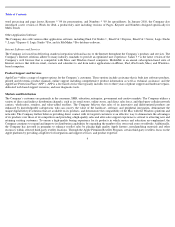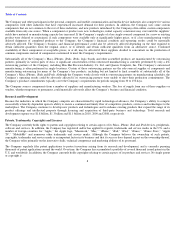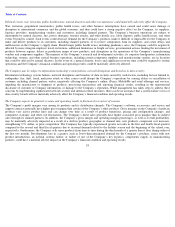Apple 2010 Annual Report Download - page 19
Download and view the complete annual report
Please find page 19 of the 2010 Apple annual report below. You can navigate through the pages in the report by either clicking on the pages listed below, or by using the keyword search tool below to find specific information within the annual report.
Table of Contents
and upgrade similar or competitive applications for the iPhone, iPad and iPod touch platforms. As with applications for the Company’
s Mac
products, the availability and development of these applications also depend on developers’
perceptions and analysis of the relative benefits of
developing software for the Company’s products rather than its competitors’
products, including devices that use competing platforms. If
developers focus their efforts on these competing platforms, the availability and quality of applications for the Company’s devices may suffer.
The Company’s future operating performance depends on the performance of distributors, carriers and other resellers.
The Company distributes its products through wholesalers, resellers, national and regional retailers, value-
added resellers, and cataloguers, many
of whom distribute products from competing manufacturers. The Company also sells many of its products and resells third-
party products in
most of its major markets directly to customers, certain education customers, cellular network carriers’
distribution channels and certain resellers
through its online and retail stores.
Many resellers operate on narrow operating margins and have been negatively affected in the past by weak economic conditions. Some resellers
have perceived the expansion of the Company’
s direct sales as conflicting with their business interests as distributors and resellers of the
Company’s products. Such a perception could discourage resellers from investing resources in the distribution and sale of the Company’
s
products or lead them to limit or cease distribution of those products. The Company’
s financial condition and operating results could be
materially adversely affected if the financial condition of these resellers weakens, if resellers stopped distributing the Company’
s products, or if
uncertainty regarding demand for the Company’s products caused resellers to reduce their ordering and marketing of the Company’
s products.
The Company has invested and will continue to invest in programs to enhance reseller sales, including staffing selected resellers’
stores with
Company employees and contractors and improving product placement displays. These programs could require a substantial investment while
providing no assurance of return or incremental revenue.
The Company’
s Retail business has required and will continue to require a substantial investment and commitment of resources and is subject to
numerous risks and uncertainties.
The Company’
s retail stores have required substantial fixed investment in equipment and leasehold improvements, information systems,
inventory and personnel. The Company also has entered into substantial operating lease commitments for retail space, with terms ranging from
five to 20 years, the majority of which are for ten years. Certain stores have been designed and built to serve as high-
profile venues to promote
brand awareness and serve as vehicles for corporate sales and marketing activities. Because of their unique design elements, locations and size,
these stores require substantially more investment than the Company’
s more typical retail stores. Due to the high fixed cost structure associated
with the Retail segment, a decline in sales or the closure or poor performance of individual or multiple stores could result in significant lease
termination costs, write-
offs of equipment and leasehold improvements, and severance costs that could materially adversely affect the
Company’s financial condition and operating results.
Many factors unique to retail operations, some of which are beyond the Company’
s control, pose risks and uncertainties that could materially
adversely affect the Company’s financial condition and operating results. These risks and uncertainties include, but are not limited to, macro-
economic factors that could have a negative effect on general retail activity, as well as the Company’
s inability to manage costs associated with
store construction and operation, inability to sell third-
party products at adequate margins, failure to manage relationships with existing retail
channel partners, more challenging environment in managing retail operations outside the U.S., costs associated with unanticipated fluctuations
in the value of retail inventory, and inability to obtain and renew leases in quality retail locations at a reasonable cost.
16
























